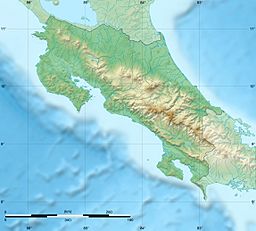Orosí Volcano facts for kids
Quick facts for kids Orosí Volcano |
|
|---|---|

SW view of Orosi, 1989
|
|
| Highest point | |
| Elevation | 1,659 m (5,443 ft) |
| Listing | List of volcanoes in Costa Rica |
| Geography | |
| Parent range | Cordillera de Guanacaste |
| Geology | |
| Mountain type | Stratovolcano |
| Last eruption | ~3500 years ago |
The Orosí Volcano, also known in Spanish as Volcán Orosí, is a large, inactive volcano in Costa Rica. It is located in the Cordillera de Guanacaste mountain range, very close to the border with Nicaragua. The area around the volcano is a popular place for tourists. Many people visit because of its amazing nature and many different kinds of plants and animals. This includes the Guanacaste National Park.
Contents
About Orosí Volcano
The Orosí Volcano is part of a group of volcanoes. This group includes Orosí itself, along with Orosilito, Volcán Pedregal, and Cacao. The highest point in this volcanic area is Volcán Cacao. It stands 1,659 meters (about 5,443 feet) tall. Cacao is located about 5.5 kilometers (3.4 miles) southeast of Orosí.
What does it look like?
If you look at Volcán Orosí from the north or west, it has a cone shape. However, its sides are very old and worn down by weather and time. This means the volcano doesn't look as perfectly cone-shaped as some younger volcanoes. Large trees and plants now cover much of its surface.
Is Orosí active?
Orosí is considered an inactive volcano. This means it has not erupted in a very long time and is not expected to erupt again. There were reports of eruptions from Orosí in 1844 and 1849. But even back then, scientists thought these eruptions might have actually come from a nearby volcano. That volcano is called Rincón de la Vieja, which is still active today.
Studying nature at Orosí
At the bottom of the Orosí Volcano, you can find the Maritza Biological Station. This station is a special place where scientists study aquatic biology. Aquatic biology is the study of living things in water, like rivers, lakes, and ponds. The station was started with help from the Stroud Water Research Center in Pennsylvania, USA. They work together to learn more about water environments and the creatures that live in them.
See also
 In Spanish: Volcán Orosí para niños
In Spanish: Volcán Orosí para niños


